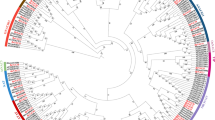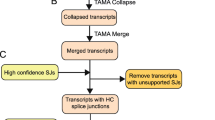Abstract
Main conclusion
A large proportion of genes in plant genomes are organized as gene families. Whereas most gene families in the aquative plant Spirodela are reduced in their copy number, the PPR gene family is expanded, which match the RNA editing sites in organelles, providing us with new insights in the evolution of flowering plants.
Pentatricopeptide-repeat proteins (PPRs) are nuclear-encoded proteins that are targeted to mitochondria and plastids to stabilize and edit mRNA transcribed from organellar genomes. They have been described for many terrestrial plant species from a diverse spectrum of sequenced genomes. To further increase our understanding of the evolution of this gene family across angiosperms, we analyzed the PPR genes in the aquatic species Spirodela polyrhiza in the order of the Alismatales (monocotyledonous plants). Because we had generated next generation sequencing data from transcripts and had sequenced the genome of Spirodela polyrhiza, we were able to identify its PPR genes and determine the level of their expression. In total, we could identify 556 PPR proteins, of which 238 members belong to the P (P motif) subfamily that is mainly involved in RNA stabilization and 318 ones to the PLS (P, Longer P, shorter P motif) subfamily responsible for RNA editing. Compared to other angiosperms, this is a large increase in the copy number of the PLS-PPRs subfamily and the expansion correlates with the increase of the number of RNA editing sites of organellar transcripts. Expression of PPR was generally stable even during growing and dormant stages, indicating that their function was critical throughout development. However, PPRs, especially those of the PLS subfamily, were expressed at relatively low levels, suggesting a delicate fine-tuning of its trans-acting function in the post-transcriptional regulation of gene expression. Thus, understanding PPR evolution and expression will help decipher the PPR code for their binding sites, which could genetically engineer RNA-binding proteins toward desired sequence.






Similar content being viewed by others
Abbreviations
- PPR:
-
Pentatricopeptide-repeat proteins
- P:
-
P motif
- L:
-
Longer P motif
- S:
-
Shorter P motif
- Mb:
-
Million bases
References
Babushok DV, Ostertag EM, Kazazian HH Jr (2007) Current topics in genome evolution: molecular mechanisms of new gene formation. Cell Mol Life Sci 64:542–554
Barkan A, Small I (2014) Pentatricopeptide repeat proteins in plants. Annu Rev Plant Biol 65:415–442
Cheng S, Gutmann B, Zhong X, Ye Y, Fisher MF, Bai F, Castleden I, Song Y, Song B, Huang J, Liu X, Xu X, Lim BL, Bond CS, Yiu SM, Small I (2016) Redefining the structural motifs that determine RNA binding and RNA editing by pentatricopeptide repeat proteins in land plants. Plant J 85:532–547
Colcombet J, Lopez-Obando M, Heurtevin L, Bernard C, Martin K, Berthome R, Lurin C (2013) Systematic study of subcellular localization of Arabidopsis PPR proteins confirms a massive targeting to organelles. RNA Biol 10:1557–1575
Eddy SR (1998) Profile hidden Markov models. Bioinformatics 14:755–763
Emanuelsson O, Brunak S, von Heijne G, Nielsen H (2007) Locating proteins in the cell using TargetP, SignalP and related tools. Nat Protoc 2:953–971
Fujii S, Small I (2011) The evolution of RNA editing and pentatricopeptide repeat genes. New Phytol 191:37–47
Hein A, Polsakiewicz M, Knoop V (2016) Frequent chloroplast RNA editing in early-branching flowering plants: pilot studies on angiosperm-wide coexistence of editing sites and their nuclear specificity factors. BMC Evol Biol 16:23
Hsu PD, Lander ES, Zhang F (2014) Development and applications of CRISPR-Cas9 for genome engineering. Cell 157:1262–1278
Liu YJ, Xiu ZH, Meeley R, Tan BC (2013) Empty pericarp5 encodes a pentatricopeptide repeat protein that is required for mitochondrial RNA editing and seed development in maize. Plant Cell 25:868–883
Lurin C, Andres C, Aubourg S, Bellaoui M, Bitton F, Bruyere C, Caboche M, Debast C, Gualberto J, Hoffmann B, Lecharny A, Le Ret M, Martin-Magniette ML, Mireau H, Peeters N, Renou JP, Szurek B, Taconnat L, Small I (2004) Genome-wide analysis of Arabidopsis pentatricopeptide repeat proteins reveals their essential role in organelle biogenesis. Plant Cell 16:2089–2103
Nakajima Y, Mulligan RM (2001) Heat stress results in incomplete C-to-U editing of maize chloroplast mRNAs and correlates with changes in chloroplast transcription rate. Curr Genet 40:209–213
Okuda K, Myouga F, Motohashi R, Shinozaki K, Shikanai T (2007) Conserved domain structure of pentatricopeptide repeat proteins involved in chloroplast RNA editing. Proc Natl Acad Sci USA 104:8178–8183
O’Toole N, Hattori M, Andres C, Iida K, Lurin C, Schmitz-Linneweber C, Sugita M, Small I (2008) On the expansion of the pentatricopeptide repeat gene family in plants. Mol Biol Evol 25:1120–1128
Pfalz J, Liere K, Kandlbinder A, Dietz KJ, Oelmuller R (2006) pTAC2, -6, and -12 are components of the transcriptionally active plastid chromosome that are required for plastid gene expression. Plant Cell 18:176–197
Pusnik M, Small I, Read LK, Fabbro T, Schneider A (2007) Pentatricopeptide repeat proteins in Trypanosoma brucei function in mitochondrial ribosomes. Mol Cell Biol 27:6876–6888
Reed ML, Lyi SM, Hanson MR (2001) Edited transcripts compete with unedited mRNAs for trans-acting editing factors in higher plant chloroplasts. Gene 272:165–171
Ruwe H, Castandet B, Schmitz-Linneweber C, Stern DB (2013) Arabidopsis chloroplast quantitative editotype. FEBS Lett 587:1429–1433
Stern DB, Goldschmidt-Clermont M, Hanson MR (2010) Chloroplast RNA metabolism. Annu Rev Plant Biol 61:125–155
Stomp AM (2005) The duckweeds: a valuable plant for biomanufacturing. Biotechnol Annu Rev 11:69–99
Trapnell C, Roberts A, Goff L, Pertea G, Kim D, Kelley DR, Pimentel H, Salzberg SL, Rinn JL, Pachter L (2012) Differential gene and transcript expression analysis of RNA-seq experiments with TopHat and Cufflinks. Nat Protoc 7:562–578
Wang W, Messing J (2011) High-throughput sequencing of three Lemnoideae (duckweeds) chloroplast genomes from total DNA. PLoS One 6:e24670
Wang W, Messing J (2012) Analysis of ADP-glucose pyrophosphorylase expression during turion formation induced by abscisic acid in Spirodela polyrhiza (greater duckweed). BMC Plant Biol 12:5
Wang W, Haberer G, Gundlach H, Glasser C, Nussbaumer T, Luo MC, Lomsadze A, Borodovsky M, Kerstetter RA, Shanklin J, Byrant DW, Mockler TC, Appenroth KJ, Grimwood J, Jenkins J, Chow J, Choi C, Adam C, Cao XH, Fuchs J, Schubert I, Rokhsar D, Schmutz J, Michael TP, Mayer KF, Messing J (2014a) The Spirodela polyrhiza genome reveals insights into its neotenous reduction fast growth and aquatic lifestyle. Nat Commun 5:3311
Wang W, Wu Y, Messing J (2014b) RNA-Seq transcriptome analysis of Spirodela dormancy without reproduction. BMC Genom 15:60
Wang W, Zhang W, Wu Y, Maliga P, Messing J (2015) RNA editing in chloroplasts of Spirodela polyrhiza, an aquatic monocotelydonous species. PLoS One 10:e0140285
Yuan Q, Ouyang S, Wang A, Zhu W, Maiti R, Lin H, Hamilton J, Haas B, Sultana R, Cheung F, Wortman J, Buell CR (2005) The institute for genomic research Osa1 rice genome annotation database. Plant Physiol 138:18–26
Zhao S, Fung-Leung WP, Bittner A, Ngo K, Liu X (2014) Comparison of RNA-Seq and microarray in transcriptome profiling of activated T cells. PLoS One 9:e78644
Acknowledgments
We thank Drs. Wei Zhang and Pal Maliga for their critical suggestion and review. We are grateful for the financial support from the Selman Waksman Chair in Molecular Genetics to JM.
Author information
Authors and Affiliations
Corresponding author
Ethics declarations
Conflict of interest
The authors declare they have no competing interests.
Electronic supplementary material
Below is the link to the electronic supplementary material.
Rights and permissions
About this article
Cite this article
Wang, W., Wu, Y. & Messing, J. Genome-wide analysis of pentatricopeptide-repeat proteins of an aquatic plant. Planta 244, 893–899 (2016). https://doi.org/10.1007/s00425-016-2555-x
Received:
Accepted:
Published:
Issue Date:
DOI: https://doi.org/10.1007/s00425-016-2555-x




